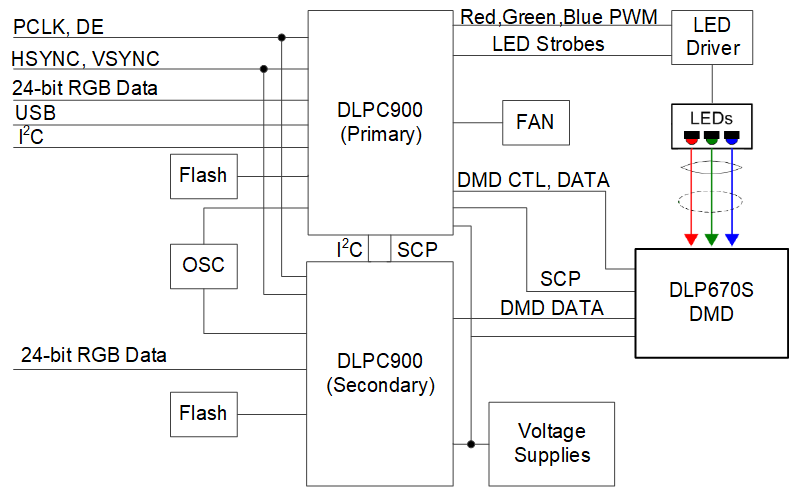JAJSIM5A November 2020 – June 2022 DLP670S
PRODUCTION DATA
- 1 特長
- 2 アプリケーション
- 3 概要
- 4 Revision History
- 5 Pin Configuration and Functions
-
6 Specifications
- 6.1 Absolute Maximum Ratings
- 6.2 Storage Conditions
- 6.3 ESD Ratings
- 6.4 Recommended Operating Conditions
- 6.5 Thermal Information
- 6.6 Electrical Characteristics
- 6.7 Capacitance at Recommended Operating Conditions
- 6.8 Timing Requirements
- 6.9 Typical Characteristics
- 6.10 System Mounting Interface Loads
- 6.11 Micromirror Array Physical Characteristics
- 6.12 Micromirror Array Optical Characteristics
- 6.13 Window Characteristics
- 6.14 Chipset Component Usage Specification
- 7 Detailed Description
- 8 Application and Implementation
- 9 Power Supply Recommendations
- 10Layout
- 11Device and Documentation Support
- 12Mechanical, Packaging, and Orderable Information
3 概要
430 万個を超えるマイクロミラーを搭載した DLP670S デジタル・マイクロミラー・デバイス (DMD) は、入射光の振幅、方向、位相を変調する空間光変調器 (SLM) です。この DMD は、4 つの 2xLVDS 入力データ・バスとの組み合わせにより、非常に高速なパターン・レートで高分解能パターンを表示できます。DLP670S は高分解能で高速なパターン・レートを実現しており、産業用、医療用、および高度な画像処理アプリケーションを幅広くサポートするのに最適です。DLP670S の機能と動作の高い信頼性 は、デュアル DLPC900 デジタル・コントローラと組み合わせることで実現されます。この専用チップセットは、さまざまな最終製品ソリューションの要件を満たすのに必要な高いパターン・レートで、柔軟でプログラムしやすいパターンを提供します。
高分解能は、3Dマシン・ビジョン・アプリケーションで大型の物体をスキャンする際に直接的な利点があります。
DLP670S を使用して設計を開始する方法については、TI の DLP® 高度光制御テクノロジーのページをご覧ください。TI.com で利用できる DLP 高度光制御のリソースには、評価基板、リファレンス・デザイン、光学モジュール・メーカー、DLP デザイン・ネットワーク・パートナーなどが含まれており、製品開発期間の短縮に役立ちます。
表 3-1 製品情報
| 部品番号 | パッケージ | 本体サイズ (公称) |
|---|---|---|
| DLP670S(1) | FYR (350) | 35mm × 32mm |
(1) 利用可能なパッケージについては、このデータシートの末尾にある注文情報を参照してください。
 DLP670S の概略回路図
DLP670S の概略回路図